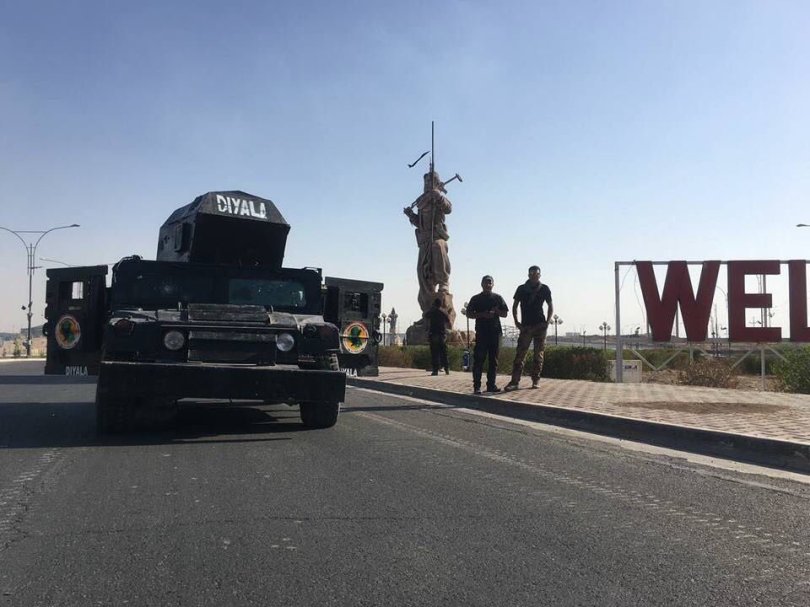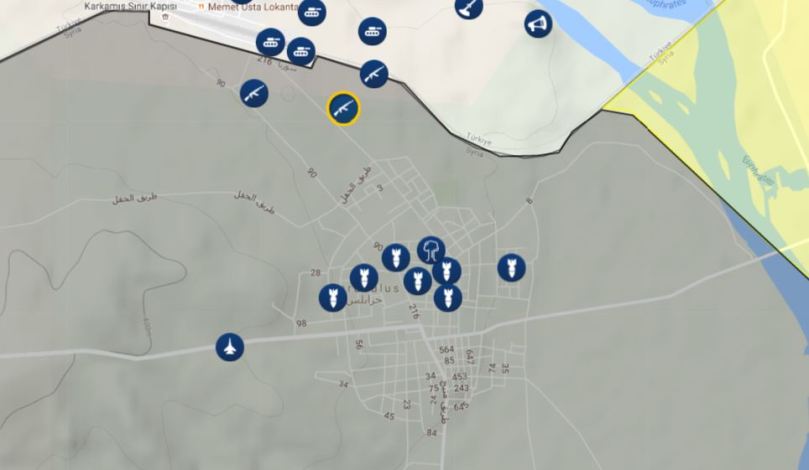At midnight on October 15 the Iraqi Army, with Iranian backed militias leading the way, launched an assault on Iraqi Kurdistan to conquer the city of Kirkuk and control the vital oil infrastructure in the surrounding countryside.


At midnight on October 15 the Iraqi Army, with Iranian backed militias leading the way, launched an assault on Iraqi Kurdistan to conquer the city of Kirkuk and control the vital oil infrastructure in the surrounding countryside.

Several convoys containing a number of American Stryker APCs has been spotted driving from the eastern side of the Euphrates river in northern Syria and entering the Kurdish held city of Manbij. The vehicles were armed with a a 12.7 and 7.62mm machine guns, and bear clear unit markings. The Strykers were clearly identifiable as American due to the large American flags shown flying high over the several of the vehicles. Also shown are HMMWVs bracketing the convoys from the front and rear.
Unverified pictures of #US Army Strykers reportedly taken near Manbij #Syria pic.twitter.com/RcC845SC6n
— Joseph Dempsey (@JosephHDempsey) March 4, 2017

This is a big leap for American involvement in the Syrian conflict. While there have been Special Operations Forces (SOF) in Syria prior to this deployment, they kept a low profile and moved around in non-standard vehicles. The forces now in Manbij are not only using standard American equipment, but the equipment itself is also clearly marked with American flags and unit markings that overtly signal an American presence .
The reason for this deployment was made apparent shortly after first pictures emerged, with the U.S has announcing that it is increasing it’s presence in Manbij to “deter hostile acts, enhance governance & ensure there’s no persistent YPG presence.” In other words, the troops are meant to assure the Turks that there are no YPG units operating with the Syrian Democratic Forces west of the Euphrates. Implicitly (and more importantly) ,the troops are also meant to deter Turkey from taking further action against the America’s partners in Syria.
Photos by @Delilsouleman of significant US convoy at Yalanli village, near Manbij pic.twitter.com/O2QaiuZGnw
— aris roussinos (@arisroussinos) March 5, 2017
As Turkey has expanded it’s zones of control it has attacked both ISIS and the Syrian Kurds, viewing them both as a threat to Turkish security. Recently, Erdogen vowed to take Manbij after the capture of Al-Bab was completed. With clashes ongoing around the edge of the salient it’s clear the Turkish president was serious about his threat.
Because the United States is relying on Kurdish forces to take the Islamic State capital of Raqqa, Turkish aggression against the SDF is clearly damaging to American objectives in Syria. It appears that rather than try to talk Erdogan out of an offensive, the Trump Administration has decided to simply present him with a fait accompli, by placing American forces in the way of an Turkish/FSA advance.
With American troops now in Manbij, Turkish aggression against SDF forces has been all but ruled out, similar to how the introduction of Russian forces in regime areas ruled out western military action against Assad. The political risks are too high and diplomatic repercussions are simply too severe. This is especially given the fact the SDF has also invited Russian convoys and regime troops into the city and has agreed to hand over some areas west of the city to government control.
What this situation creates is a multi-national tripwire that will prevent Turkish-backed forces from attacking SDF controlled territory. With the regime controlling the western approaches to the city the introduction of Russian advisers to those areas is inevitable. If Turkey wants Manbij, they will have to go through Russian, Syrian and American troops to get to it.
The U.S has denied coordination with Russia and the regime and their presence seems to be of solely the work of the SDF. Turkey, for it’s part is now threatening to stop it’s military operations against ISIS unless the United States and Russia “cooperate” with Turkey on the issue. What will happen next is up in air, but for now, the SDF are safe from Turkish aggression and this will hopefully allow them to concentrate more of their forces against ISIS rather than having to leave them in the north to fight to FSA, who are nowhere near the ISIS capital in Raqqa.

Turkey has launched a military intervention to clear ISIS from the border region around the city of Jarablus in northern Syria. Dubbed “Operation Euphrates Shield” 3000–5000 FSA fighters have entered Syria along with a 25 tanks, multiple IFVs, and Turkish special forces troops.
The ground incursion follows hours of bombardment by Turkish artillery and fighter jets which are still striking ISIS positions in area. Warplanes from the U.S-led coalition have also been carrying out airstrikes and the U.S has committed to support the operation from the air as it continues.

Turkey’s interests in Syria are varied. Aside from the removal of Assad, one of Turkey’s main goals in Syria is to prevent the formation of a self-governing Kurdish entity on the border in Syria. While the U.S has backed the YPG/SDF against ISIS, Turkey still views them as an offshoot of the PKK, a Kurdish political party and insurgent group that they have been fighting for decades.
In the previous months the SDF has been quickly taking ground against ISIS in northern Syria with the help of U.S air power. Fresh from their victory against ISIS at Manbij the prospect that they could link their eastern territories with the enclave around Afrin is increasing by the day.
The Turkish assault against ISIS in Jarablus then, is widely seen as a ploy to prevent the SDF from taking the city first and denying the Kurds the ability to unify the Kurdish regions of Syria and create an independent state on Turkey’s southern border.

So far Turkey has committed to securing a 70 km line between Marea (north of Aleppo) and Jarablus. Assaults on SDF positions can’t be ruled out though. Already, clashes have broken out between the Turkish backed FSA with Turkish tanks firing on SDF fighters. The name of the operation also seems to hint at Turkey’s intention to push the Kurds across the Euphrates.
Erdogen has promised to target the YPG* and has threatened them with direct action if they refuse to withdraw to the western side of the Euphrates. The threat seems to have works as the YPG announced that they will pull back** from the western side of the Euphrates but the remaining SDF elements have stated that they will remain. Whether this will be enough to satisfy the Turks is unknown, but it’s clear the YPG do not want to fight the Turkish army directly or lose U.S support.
The question now is, how far will this intervention go? With the SDF marching toward the city of Al-Bab, the prospect of unifying the Kurdish territories still exists, even without direct YPG involvement.
From a military standpoint Al-Bab is a major junction in the area that links Manbij with Aleppo via the M4 and 212 highways. It also links the two Kurdish territorial blocks through a series of minor roads. If Al-Bab is captured by the YPG it will allow the flow of men and material through the Kurdish territories from Afrin to the Iraqi border.
If Turkey intends to stop the spread of the SDF’s territory then capturing Al-Bab will be necessary. There is also the possibility that today’s clashes along the front with the SDF foreshadow a larger offensive against them. If so, the line the Turks are drawing may be as deep as it is wide and could stretch to Manbij.
*The YPG is a component faction of the SDF
**UPDATE: Now getting reports from the YPG spokesman that they will not pull out.